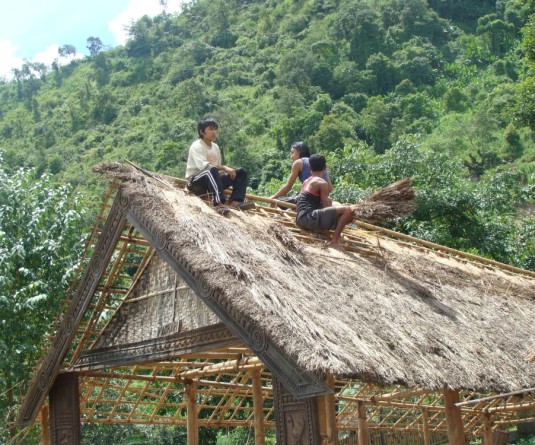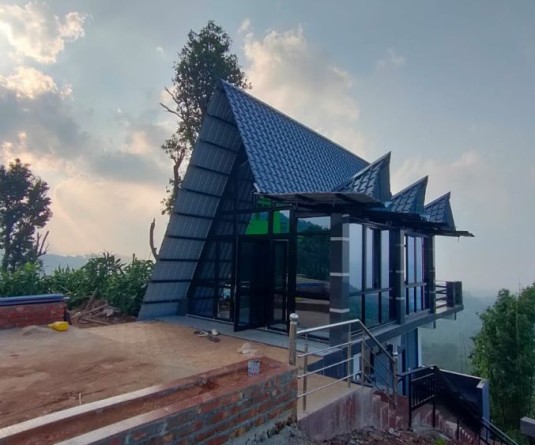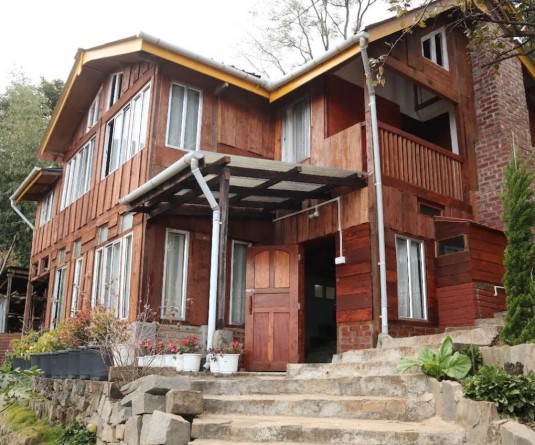The main arterial road of Somra village is on its way to being black-topped for the first time in history. With a new hospital and a monastery, this sub-township in Burma seeks to be upgraded to a township by 2015. (Morung Photo)
Morung Express Feature
Somra | May 20
Somra’s arterial road is neatly covered in cut stone, on their way to being black topped for the first time in history. This village in Burma is also due to get a hospital soon and one government school exists; add to this a Buddhist monastery at the top of the village (a compulsion if the area is to be upgraded), and it will be declared a township by 2015. The houses in the village bear careful craftsmanship—decorative balconies, carved out ventilations, curved arches—in wood. House walls made of neatly cut wood placed in clean horizontal lines with monoliths in each yard. Somra’s neatness and sophistication of home craft had never been relayed.
Nor had been relayed the resilience of the people of Somra to access modern necessity. Crooked wooden electric poles forming the cross that electric poles do stood erect through the village at even intervals. At some public points, CFL lamps had been strung from the loose wiring between the poles. Was this the result of a communitisation program initiated by the State, perhaps? Not.
The village council had come up with the idea to supply electricity to the village through a rice mill generator! Timings were allocated for the supply of electricity during the day for certain number of hours—based on this some people access satellite television in Somra. People refused to succumb to darkness while the state suppressed them in myriad ways.
For instance, Naga markers of village identity, its feast-of-merit houses, grand gates, granaries or woven skirts were ominously missing. The more than 50 years of military repression had wiped out all outward signs of Naga identity. Green, the junta’s chosen colour, and a purple-and-green striped skirt with horizontal white embroidery through the middle was enforced on the people so that the military could identify who these people are. The Kachin, Chin, Shan or Mon had clothing with which the military could identify them, and take actions accordingly. The Nagas, however, wore different colours and showed erratic traits in clothing. So the skirt, with its alien embroidery was to be worn.
To the third eye today, it is impossible to tell who the people walking around in Burmese checked lungis in Somra are unless kin and clan lines are traced back. Like most Tangkhul dialects, the Somra dialect could not be understood in its spoken form by the visiting team. There are seven Naga tribes that the Government of Burma recognizes (the Naga Youth Organisation in Burma lists 23), and the lack of organisation among them is one of the factors that has resulted in a loose solidarity for rights.
Little help came from India. The Nagas on the Indian side have moved on, at times out of convenience, at others out of compulsion. It has left the Nagas in Burma hanging, a part till recently neither of Burma, nor the imagined Naga nation.
The musicians from Ukhrul remained subversive to this. They sang and played in concert; the group partaking in the seed-sowing festivities at the Somra town hall. Not only did children and teenagers participate, three old women obliged by dancing on stage to a Tangkhul classic. In a pork eating (biting off, more so) competition, the visitors from Ukhrul became one with the citizens of Somra as the cultural chief of the village shoved in a chunk of pork into their mouth, one at a time, to ritual singing. This was after the team had had their fill at separate peer group lunches at households spread out.
Somra did not just enjoy the interaction, its people equally displayed talent. After the local fashion show, a surprise hit the ear. Spanish classic Romanza filled the town hall in the evening. 20 year-old Robert Horam, who played the complicated piece on his guitar, is the first person from the village to have studied music and can read staff notation. Robert did his schooling from Imphal, after which he trained in church music in Siliguri. If he is given a visa, he will pursue further studies in music in, hopefully, Singapore.
This is one among the many dreams that the youth of Somra weave. There are limited opportunities for most of them, however. Till date, like the past half a century, the military forces labour out of people from the Naga areas in Burma, and wages are hard to come by. If jobs are rare in North East India, they are negligible in North West Burma. Indian money from Ukhrul is sought after but sources of regular income remain sparse, and the people peripheral.
This year’s theme for the festival in Somra was ‘Education: the Light of the World’. In the light of the current initiative, more than what is imparted in school, in India or in Burma, the education that is transferred from people to people, the opportunities, will amount to the future that Naga people profess to share.
Today, whether it is the Tangsa (Tangshang) people in Arunachal Pradesh, Konyak and Khiamniungan in Nagaland or the Tangkhul in Manipur who lay physically divided between India and Burma, its repercussions reflect on the Naga people as a whole. The act of initiating dialogue and negating what the Nagas have always termed “imagined” and “unfair” boundaries flavour the meaning of Naga rights: the responsibility of this is not just of these tribes but of all Naga people.
Weaving across borderlines sends a message that peripheries too have a core; the resultant osmosis can be a basis for reinforcing existing ideas, of extending solidarity; of bringing our advantage to those who are yet to access what we have. The Somra Initiative seeks to imagine a reality thus produced, and create possibilities that go beyond imagination.
Concluded






